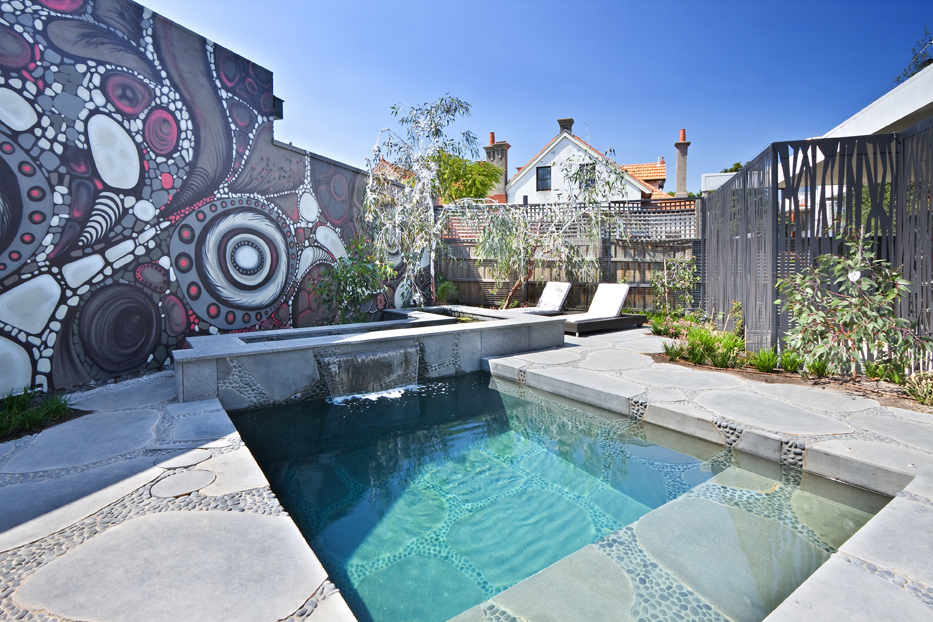I frequently quote jobs for clients who would like to build a “plunge pool”. Despite my 25 years of experience in the Melbourne pool industry I don’t have an innate understanding of what a plunge pool is. And in researching this blog I delved no deeper (pardon the pun) than a Googled description; “a pool at the base of a waterfall formed by the plunging, scoop of a waterfall”. In my mind’s eye, I can see the backdrop for a Norsca commercial, but not necessarily the suburban dream of a backyard pool for the kids.
These deep, compact pools described as plunge pools are a consequence of modern city and suburban living and the compressed spaces we now occupy. Big houses, small land allotments and high property values create conditions whereby utility defines value. Pools are now being built on impossibly small and marginal areas of land within building blocks and if you can’t build a pool big enough to swim in, then at least build one big enough to “get wet” in.
In the 70’s and 80’s the average size swimming pool in Melbourne was 9x 4.5m or approx. 40sqm. Since then, home size has increase from the 12 -14 square homes of the 50’s and 60’s and pools have had to adapt. In the 90’s building codes became looser and homes were now built right up to property boundaries with footprints in the 1990’s and 2000’s up to 30-40 squares. As a result, “plunge pools”, became the only type of pool that could be built within the small parcels of land leftover from the footprint of the new home constructions.
I think any pool smaller than 6m x 3m or 18 sqm could be classified as a plunge pool; with a further categorisation that the floor of a plunge pool would tend to be uniform in depth instead of the clearly defined deep end to shallow end profile of the average pool.
Plunge pools in reality are just small pools, with no clearly defined criteria to differentiate them from normal swimming pools.
Plunge pool advantages and disadvantages
I hear all kinds of reasons for wanting a plunge pool, but people sometimes leave out what, to me, is their biggest benefit- aesthetics. Plunge pools add an undeniable appeal and glamour to any space. They’re eye-catching and can turn an ugly or awkward space – such as the gap between the home and fence – in to a real feature.
Compared to a full size pool, the downside is obvious – you can’t do much swimming in them. This means they’re sometimes less popular with the kids because there isn’t enough space for kids to race one another or play pool games.
For adults, though, this may hardly be a disadvantage. You can still cool off on a hot summer’s day with friends, or turn on the jets and use them like a spa in winter. For that I think they’re often better than a full size pool- their small size is better for socialising with a drink or two, and they’re cheap to heat during winter.

This plunge pool built in Carlton is fitted to both the property boundary and the home boundary whilst forming a focal point for the eye from the living areas
Helpful hints for building a plunge pool or small pool
- Build the pool tight to the space available, this means make use of property and fence boundaries.
- Make the pool deeper than normal i.e (shallow end depth of 1.4m instead of the standard 1.2m ). That way you increase the feel and volume of the pool in the third dimension (depth), which offsets the fixed constraints of Length and Width. The deep end water depth could be the same as the average pool ( 1.7m) or less. Pointless making it deeper as you can’t dive into a pool of this depth or surface area.
- Build seating into the pool – so you can get wet and relax.
- Don’t waste space on building step entries as you won’t necessarily have the space to waste, not to mention elegantly entering a pool through a step entry seems at odds with the description of a “plunge pool”.
- A spa seat with jets can be easily built into the plunge pool form – so it fits more than one purpose.
- The small volume of a plunge pool means it can easily be heated with a heating system be that solar or gas – this further increases the utility of the structure.

This plunge pool in St Kilda is complete with its own “plunging watercourse”, whilst the bluestone round pavers and pebble inlay are a modern take on the pool at the base of a rock waterfall. Note how the pool is used as a focal point in the backyard as the available land constricts and tapers towards the rear fence. The eye stays fixed on the pool set at a splayed angle to mitigate the irregular shapes.
